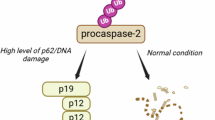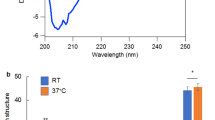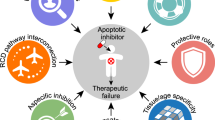Abstract
In human cell lines, the caspase 2 adaptor RAIDD interacts selectively with caspase 2 through its caspase recruitment domain (CARD) and leads to caspase 2-dependent death. Whether RAIDD induces such effects in neuronal cells is unknown. We have previously shown that caspase 2 is essential for apoptosis of trophic factor-deprived PC12 cells and rat sympathetic neurons. We report here that rat RAIDD, cloned from PC12 cells, interacts with rat caspase 2 CARD. RAIDD overexpression induced caspase 2 CARD- and caspase 9-dependent apoptosis of PC12 cells and sympathetic neurons. Apoptosis correlated with the formation of discrete perinuclear aggregates. Both death and aggregates required the expression of full-length RAIDD. Such aggregates may enable more effective activation of caspase 2 through close proximity. Following trophic deprivation, RAIDD overexpression increased death and aggregate formation. Therefore, RAIDD aggregation is important for its death-promoting effects and may play a role in trophic factor withdrawal-induced neuronal apoptosis.
Similar content being viewed by others
Log in or create a free account to read this content
Gain free access to this article, as well as selected content from this journal and more on nature.com
or
Abbreviations
- AA:
-
amino acid
- Ab:
-
antibody
- CARD:
-
caspase recruitment domain
- DD:
-
death domain
- DED:
-
death effector domain
- MTOC:
-
microtubule organizing center
- NMR:
-
nuclear magnetic resonance
- ORF:
-
open-reading frame
- WT:
-
wild type
References
Rideout HJ and Stefanis L (2001) Caspase inhibition: a potential therapeutic strategy in neurological diseases. Histol Histopathol 16: 895–908
Troy CM and Salvesen GS (2002) Caspases on the brain. J Neurosci Res 69: 145–150
Shi Y (2002) Mechanisms of caspase activation and inhibition during apoptosis. Mol Cell 9: 459–470
Van de Craen M, Declercq W, Van den brande I, Fiers W and Vandenabeele P (1999) The proteolytic procaspase activation network: an in vitro analysis. Cell Death Differ 6: 1117–1124
Slee EA, Harte MT, Kluck RM, Wolf BB, Casiano CA, Newmeyer DD, Wang HG, Reed JC, Nicholson DW, Alnemri ES, Green DR and Martin SJ (1999) Ordering the cytochrome c-initiated caspase cascade: hierarchical activation of caspases-2, -3, -6, -7, -8, and -10 in a caspase-9-dependent manner. J Cell Biol 144: 281–292
Li H, Bergeron L, Cryns V, Pasternack MS, Zhu H, Shi L, Greenberg A and Yuan J (1997) Activation of caspase-2 in apoptosis. J Biol Chem 272: 21010–21017
Keramaris E, Stefanis L, MacLaurin J, Harada N, Takaku K, Ishikawa T, Taketo MM, Robertson GS, Nicholson DW, Slack RS and Park DS (2000) Involvement of caspase 3 in apoptotic death of cortical neurons evoked by DNA damage. Mol Cell Neurosci 15: 368–379
Duan H and Dixit VM (1997) RAIDD is a new ‘death’ adaptor molecule. Nature 385: 86–89
Ahmad M, Srinivasula SM, Wang L, Talanian RV, Litwack G, Fernandes-Alnemri T and Alnemri ES (1997) CRADD, a novel human apoptotic adaptor molecule for caspase-2, and FasL/tumor necrosis factor receptor-interacting protein RIP. Cancer Res 57: 615–619
Koseki T, Inohara N, Chen S and Nunez G (1999) ARC, an inhibitor of apoptosis expressed in skeletal muscle and heart that interacts selectively with caspases. Proc Natl Acad Sci USA 95: 5156–5160
Dowds TA and Sabban EL (2001) Endogenous and exogenous ARC in serum withdrawal mediated PC12 cell apoptosis: a new pro-apoptotic role for ARC. Cell Death Differ 8: 640–648
Harvey NL, Butt AJ and Kumar S (1997) Functional activation of Nedd2/ICH-1 (caspase-2) is an early process in apoptosis. J Biol Chem 272: 13134–13139
Paroni G, Henderson C, Schneider C and Brancolini C (2001) Caspase-2-induced apoptosis is dependent on caspase-9, but its processing during UV- or tumor necrosis factor-dependent cell death requires caspase-3. J Biol Chem 276: 21907–21915
Guo Y, Srinivasula SM, Druilhe A, Fernandes-Alnemri T and Alnemri ES (2002) Caspase-2 induces apoptosis by releasing proapoptotic proteins from mitochondria. J Biol Chem 277: 13430–13437
Paroni G, Henderson C, Schneider C and Brancolini C (2002) Caspase-2 can trigger cytochrome C release and apoptosis from the nucleus. J Biol Chem 277: 15147–15161
Lassus P, Opitz-Araya X and Lazebnik Y (2002) Requirement for caspase-2 in stress-induced apoptosis before mitochondrial permeabilization. Science 297: 1352–1354
Robertson JD, Enoksson M, Suomela M, Zhivotovsky B and Orrenius S (2002) Caspase-2 acts upstream of mitochondria to promote cytochrome c release during etoposide-induced apoptosis. J Biol Chem 277: 29803–29809
Troy CM, Stefanis L, Greene LA and Shelanski ML (1997) Nedd2 is required for apoptosis after trophic factor withdrawal, but not superoxide dismutase (SOD1) down-regulation, in sympathetic neurons and PC12 cells. J Neurosci 17: 1911–1918
Troy CM, Rabacchi SA, Hohl JB, Angelastro JM, Greene LA and Shelanski ML (2001) Death in the balance: alternative participation of the caspase-2 and -9 pathways in neuronal death induced by nerve growth factor deprivation. J Neurosci 21: 5007–5016
Stefanis L, Troy CM, Qi H, Shelanski ML and Greene LA (1998) Caspase-2 (Nedd-2) processing and death of trophic factor-deprived PC12 cells and sympathetic neurons occur independently of caspase-3 (CPP32)-like activity. J Neurosci 18: 9204–9215
Haviv R, Lindenboim L, Yuan J and Stein R (1998) Need for caspase-2 in apoptosis of growth-factor-deprived PC12 cells. J Neurosci Res 52: 491–497
Stefanis L, Park DS, Yan CYI, Farinelli SE, Troy CM, Shelanski ML and Greene LA (1996) Induction of CPP32-like activity in PC12 cells by withdrawal of trophic support: dissociation from apoptosis. J. Biol. Chem. 271: 30663–30671
Chou JJ, Matsuo H, Duan H and Wagner G (1998) Solution structure of the RAIDD CARD and model for CARD/CARD interaction in caspase-2 and caspase-9 recruitment. Cell 94: 171–180
Mancini M, Machamer CE, Roy S, Nicholson DW, Thornberry NA, Casciola-Rosen LA and Rosen A (2000) Caspase-2 is localized at the Golgi complex and cleaves golgin-160 during apoptosis. J Cell Biol 149: 603–612
Johnston JA, Ward CL and Kopito RR (1998) Aggresomes: a cellular response to misfolded proteins. J Cell Biol 143: 1883–1898
Rideout HJ and Stefanis L (2002) Proteasomal inhibition-induced inclusion formation and death in cortical neurons require transcription and ubiquitination. Mol Cell Neurosci 21: 223–238
Shearwin-Whyatt LM, Harvey NL and Kumar S (2000) Subcellular localization and CARD-dependent oligomerization of the death adaptor RAIDD. Cell Death Differ 7: 155–165
Srinivasula SM, Ahmad M, Fernandes-Alnemri T and Alnemri ES (1998) Autoactivation of procaspase-9 by Apaf-1-mediated oligomerization. Mol Cell 1: 949–957
Siegel RM, Martin DA, Zheng L, Ng SY, Bertin J, Cohen J and Lenardo MJ (1998) Death-effector filaments: novel cytoplasmic structures that recruit caspases and trigger apoptosis. J Cell Biol 141: 1243–1253
Guiet C and Vito P (2000) Caspase recruitment domain (CARD)-dependent cytoplasmic filaments mediate bcl10-induced NF-κB activation. J Cell Biol 148: 1131–1139
Angelastro JM, Moon NY, Liu DX, Yang AS, Greene LA and Franke TF (2001) Characterization of a novel isoform of caspase-9 that inhibits apoptosis. J Biol Chem 276: 12190–12200
Greene LA and Tischler AS (1976) Establishment of a noradrenergic clonal line of rat adrenal pheochromocytoma cells which respond to nerve growth factor. Proc Natl Acad Sci USA 73: 2424–2428
Cappalletti G, Maggioni MG and Maci R (1999) Influence of MPP+ on the state of tubulin polymerisation in NGF-differentiated PC12 cells. J Neurosci Res 56: 28–35
Acknowledgements
This work was supported by a grant from the March of Dimes Foundation (Grant # FY99-318 to LS). Additional support was provided by a Wellcome Burroughs Career Award in Biomedical Sciences (LS), the Lowenstein, Matheson and Parkinson's Disease Foundations (LS), the NIH/NINDS (CMT) and the MDA (CMT). We would like to thank Drs. Lloyd Greene, Michael Shelanski, Isabelle Lang-Rollin and David Park for helpful discussions, Drs. Sharad Kumar and Shearwin-Whyatt for the human RAIDD construct and Dr. Philip Bird for the PAI2 construct.
Author information
Authors and Affiliations
Corresponding author
Additional information
Edited by Dr P Nicotera
Rights and permissions
About this article
Cite this article
Jabado, O., Wang, Q., Rideout, H. et al. RAIDD aggregation facilitates apoptotic death of PC12 cells and sympathetic neurons. Cell Death Differ 11, 618–630 (2004). https://doi.org/10.1038/sj.cdd.4401397
Received:
Revised:
Accepted:
Published:
Issue date:
DOI: https://doi.org/10.1038/sj.cdd.4401397
Keywords
This article is cited by
-
Uncovering the PIDDosome and caspase-2 as regulators of organogenesis and cellular differentiation
Cell Death & Differentiation (2020)
-
RAIDD is required for apoptosis of PC12 cells and sympathetic neurons induced by trophic factor withdrawal
Cell Death & Differentiation (2006)
-
Apoptosis and the conformational change of Bax induced by proteasomal inhibition of PC12 cells are inhibited by bcl-xL and bcl-2
Apoptosis (2005)



